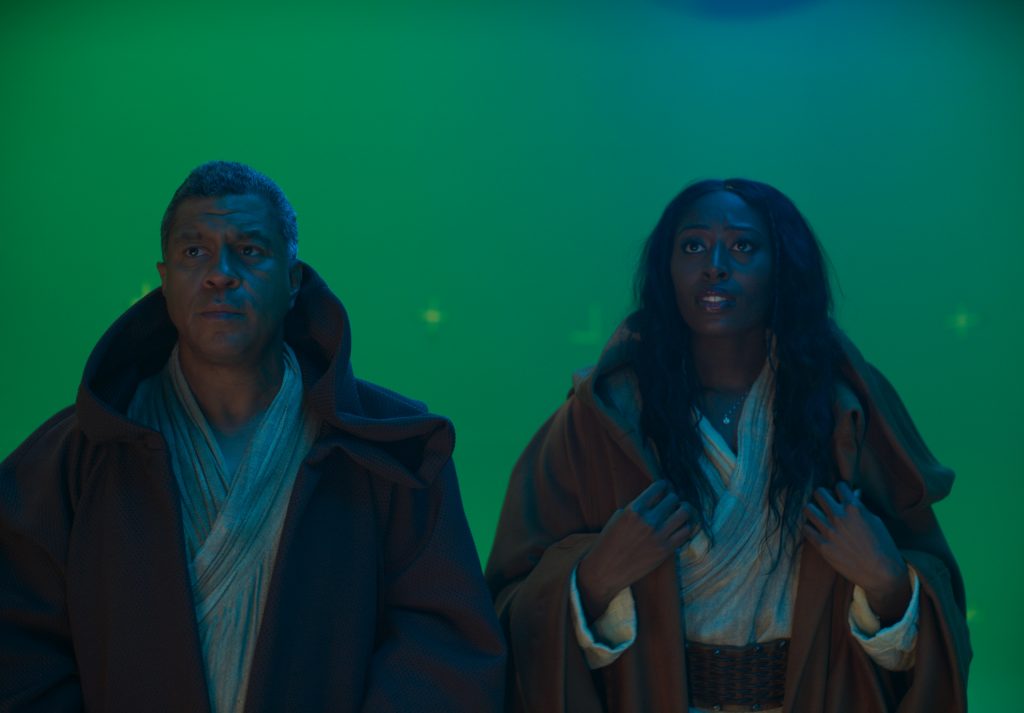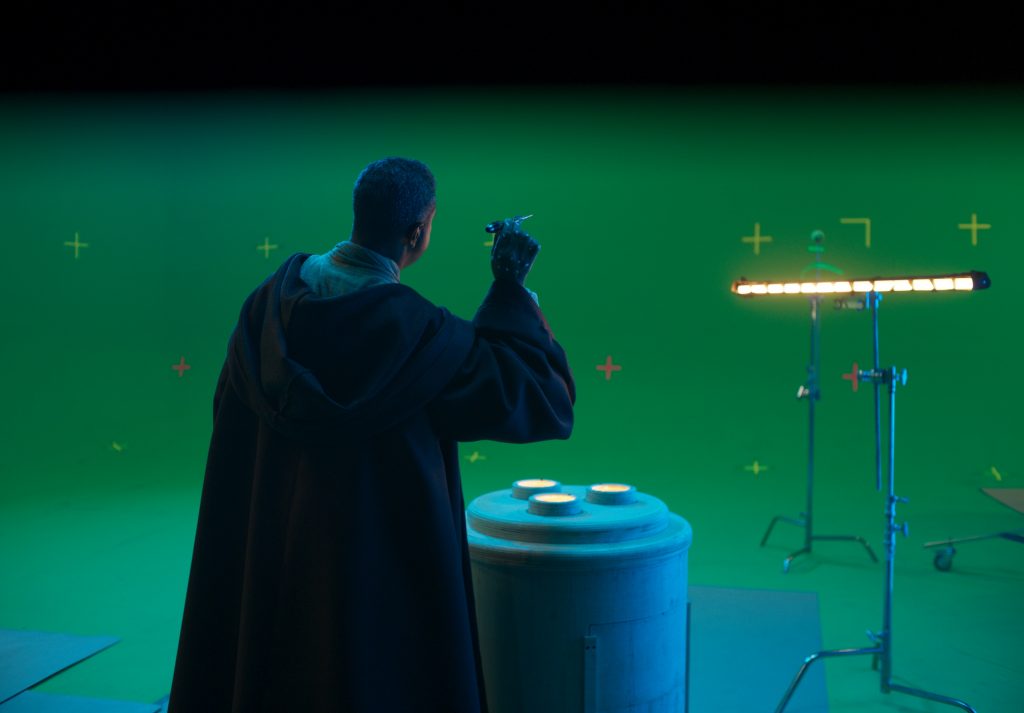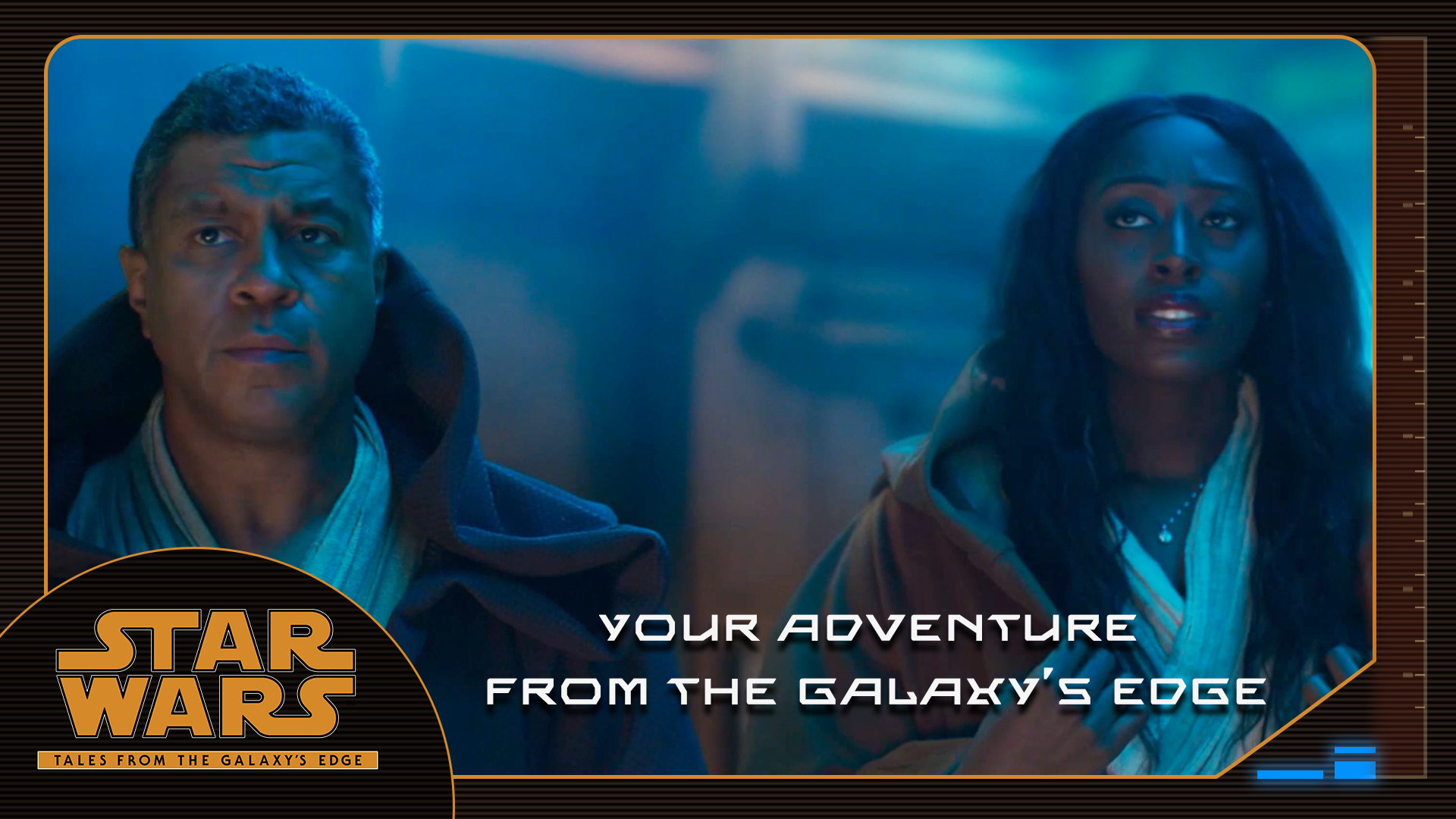Star Wars: Tales from the Galaxy’s Edge gives players the chance to explore entirely new locations and areas of the planet Batuu as they embark on a thrilling adventure in virtual reality. To celebrate the release of the game, the team at ILMxLAB collaborated with ESPN to create a television spot that let ESPN hosts Stan Verrett and Chiney Ogwumike actually visit one of the game’s most iconic locations: Seezelslak’s Cantina. While there, the duo encounter the boisterous bartender himself, Verrett tries his hand at a game of repulsor darts, and they take in the unforgettable view of the Millennium Falcon — with Ogwumike proving her Star Wars bona fides by discussing the famous ship.
To create the spot, director Jonathan Klein (ESPN’s award-winning “Jingle Hoops” commercial) collaborated with the visual effects supervisor, ILMxLAB’s Tim Alexander, to bring Tales from the Galaxy’s Edge out of VR and onto television screens. Melding live-action footage, the incredible design and environmental work of the game, and impeccable visual effects, the spot captures the spirit of Tales while also serving as a compelling piece of commercial filmmaking unto itself.
In the first installment of this two part making-of series, we talk with Klein about his filmmaking inspiration for the project, working in the time of COVID, and how to make the most realistic game of repulsor darts possible.

This spot includes a crossover of a lot of different worlds, from ILMxLAB and ESPN to Industrial Light & Magic. How did you get involved, and what was the initial concept?
I’ve been really fortunate to have a relationship with ESPN and Disney over the last few years, and have been involved in some spots for their movies, including The Rise of Skywalker and Ralph Breaks the Internet. I also did a Captain Marvel thing, so they have a sense of me as a commercial filmmaker.
ESPN Creativeworks, which is their sort of in-house agency, contacted us with the possibility that Tales from the Galaxy’s Edge was going to do a cross-promotion with ESPN talent. I’m pretty familiar with working with ESPN talent, and trying to get them out of their soundbite TV presenter mode and into acting mode, and as they showed me the script, they mentioned that Industrial Light & Magic was going to be doing the post-production.
As a boy who grew up with Star Wars, it was a pretty significant part of my filmmaking development in terms of imagination. ILM is the gold standard for me in terms of visual effects. My dad used to talk to me about Dennis Muren in the ‘80s, and the kind of stuff that he was doing with miniatures. My dad and I used to make little stop-motion animation things, and he would tell me that that’s the same thing that they’re doing out in California, which was kind of amazing for a kid in a small town in New England.
So I was overjoyed at the prospect of doing anything with ILM, and put together a treatment. And one of the things I said, because the timeline was really tight — but also selfishly — was that I wanted to be involved with ILM as early as possible. And so Tim Alexander and I were on a call, a few days after that came up.
What was your collaboration like?
I think one of the real blessings of this experience was to work with a VFX supervisor of Tim’s caliber, and as soon as we had that first conversation I knew that we were in incredible hands. Not just decent hands, but Academy Award-nominated hands.
I find that the best VFX supervisors, and the best VFX artists in general, are always open to the possibilities. And no matter how crazy your fantasy of what this shot is, and how you can do it, they tend to have a very similar demeanor about how they approach it, which is, “Sure, let’s see if we can do it.” Nothing is off the table, And that is the magic of VFX in a lot of ways. You can, with the right tools and the right attitude, make anything possible.
And with Tim it just seemed to me, as I started to have exchanges with him, that he was on board with wherever we were going. And that was exciting and invigorating.
Were you able to play Tales, so you knew what you were diving into?
I wish! My experience with Tales was limited to what was publicly available. As I’m somebody who’s outside of the Disney family, they were relatively covert in terms of what they were willing to release. Initially it was the trailers that were out there, and the behind-the-scenes “making of” trailer with the producers, Bobby Moynihan, and Debra Wilson. That was really my experience with it.
I had done VR stuff before, but no Star Wars-themed VR. Obviously I had a pretty good familiarity with the universe, and was able to get people excited in terms of not only my appetite, but the spectrum of [Star Wars] insight that I could bring to it.
I’m also a big fan of the filmmaking, just from a technical standpoint, that they do in the Star Wars universe. That was something that I was eager to apply, and had applied in a Rise of Skywalker spot as well, kind of borrowing liberally from the J.J. Abrams world. In this case, we borrowed somewhat liberally from Ron Howard.
What were some of the inspirations you took from Solo?
Some of the shots, particularly in that scene where Han first meets Lando Calrissian. I was gearing some things towards that [with the commercial’s opening shot], which is having bodies do reveals. You know, any time you’re working with a really, really short VFX window, I find that you try to really simplify things. So I made everything kind of nodal, limited to no camera moves, or just pan and tilt, so [the shots were] kind of static. That was a function of time, really. I’m sure that ILM can do anything if you ask them and you’re polite about it — and if you have the time.
In this spot you had a live-action shoot for actors that you knew were going to end up in a digital world that already existed in virtual reality. Even though you couldn’t try Tales before, did this inform your process?
It definitely did. There was a lot of discussion in terms of how much we wanted to show, and what the level of interaction would be with [Chiney and Stan] in this world. To everyone’s credit, they didn’t want to do anything that was not faithful to the actual experience of the game. That meant that a whole bantha milk section, where I was going to do a blue milk mustache on one of the characters, went out the window pretty quickly because you weren’t going to be able to drink blue milk at the bar in the game. I think they wanted to be faithful to what that Seezelslak bar experience feels like, and to suggest that this is pretty awesome on its own. You don’t need to overly dramatize it beyond how it exists in the VR space.
But yeah, it was incredibly tricky. I think it’s worth talking about my cinematographer, Rachel Morrison. Rachel shot Black Panther, and because Black Panther was so predominantly a blue screen universe, this stuff is kind of old hat to her at this point. She’s never shot a Star Wars movie, so perhaps that was something that inspired her to get excited about the project as well.
My production designer, Chelsea Oliver, was really eager to recreate the VR world to the best that we could, so we can have practical elements that give the actors some spatial relationships that they can work through, which includes everything from a bar that’s the right height, to Seeselslak’s height and eyeline, and where he would be in that moment when they enter [the cantina].
The space darts [station where Stan plays] was actually something that we built out of one of those old shop-vacs. So there was actually some fabrication involved, because we wanted to be able to give ILM some practical uplights that would interact with the hand that comes across to pluck the space dart. Because the time window in which they were trying to turn this around was so short, we wanted to give them kind of as much as possible in-camera.

What were the two ESPN hosts playing against on-set when they meet Seezelslak?
Well, Seezelslak’s pretty tall, so we built a little stand and put a Seezelslak head on it, on a pole. Originally, there was the intention that you would sort of see an over-the-shoulder version of Seezelslak [looking] back to them. I was looking through the Star Wars universe in terms of the camera language, and I really liked a cleaner shot on them instead. That moment was really about them sort of marveling [at the environment] as they pull back their hoods, as opposed to necessarily including Seezelslak in that shot.
I think for me, it was more that their performances were tinged with a little degree of conflict between them, where one was clearly a Star Wars fan, and the other a bit of a neophyte. I wanted to give that whole scene just a degree of conflict and purpose. Like, “I want to explore this as fast as possible” versus “I’m not sure what we’re exploring, where are we?” So that was more of the fulcrum upon which their performance was based, as opposed to really working off of Seezelslak.
Given that the spot was taking place in this VR environment, how much flexibility did you have in terms of staging or planning out the shots?
Again, because of the time crunch, I would say that it was slightly prescriptive in terms of the way that we were going to try to achieve it. Once we had Tim involved, and his allocation of resources, we could kind of shift around within the space, but to my understanding not everything was fully rendered and photo-finished when we actually shot the spot. I think things were still being tweaked and managed. It’s not like we could put on the VR goggles and experience Seezelslak’s bar for ourselves, and then say, “Alright, we really like this angle here.”
It was more like “These angles are lit, and rendered, and detail is done.” We did see some roughs of potential angles and placement of the characters, and we refined them a little bit and would ask Tim, “Hey, can we have a little bit over here,” or “Instead of this frontal angle, go to a little bit more of a profile angle,” which is that stacked shot of [Chiney and Stan] at the window. I guess it’s just my own personal proclivity, but I prefer shots that aren’t something that an Instragrammer or someone shooting a video themselves shoots, which they tend to shoot dead-on. I try to be off-axis, whether it’s three-quarters, underslung, or profile.
A lot of different elements came together to make this piece happen. What were some of your biggest takeaways from the process?
I learn something new every time. One of the challenges of this spot which I’m sure Tim mentioned is that he wasn’t on-set [due to COVID restrictions], which is a little bit of a difficult thing, because some of the lighting shifts that we were trying to do; [bringing the lighting] cooler when they enter the cantina, and then adding some warmth when they get over to the window.
Normally your VFX supervisor is looking at a big monitor on set, seeing what exactly is coming out of the camera, and what [color lookup table] you’re putting on it and how it looks, and throwing a rough comp in from that, versus throwing a rough comp in from whatever’s being fed to him. l would have sacrificed [having some other crew members if it meant I could] have the VFX supervisor on-set.
That’s one of the principal challenges when you’re moving fast and you’re shooting a big, green-screen world, and you’re at a relatively small crew size because of the protocols that are in place to keep everybody safe. Everything takes a little longer because you have less crew. I guess the long and short of it is always have your VFX supervisor close to hand.
In the second installment of this making-of series, we’ll talk to visual effects supervisor Tim Alexander about how he and the team at Industrial Light & Magic transformed the virtual environments of Tales from the Galaxy’s Edge.
Buy Star Wars: Tales from the Galaxy’s Edge now for Oculus Quest.

